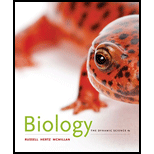
Biology: The Dynamic Science (MindTap Course List)
4th Edition
ISBN: 9781305389892
Author: Peter J. Russell, Paul E. Hertz, Beverly McMillan
Publisher: Cengage Learning
expand_more
expand_more
format_list_bulleted
Concept explainers
Question
Chapter 33.1, Problem 2SB
Summary Introduction
To review:
The meristem tissue and its types along with the role of the basic types of meristems in the development of the plant body.
Introduction:
A tissue is a group of cells that are similar in both function and structure. It works together in one or more tasks along with some intercellular substances. The plant tissues grow all their life. Unlike in animals, the tissue growth is slow and gradual and stops once the organism exceeds a certain size. This capacity of indefinite growth provides the plant an inordinate amount of functional and anatomical plasticity in order to reciprocate through the environmental influences like light, water, temperature, and nutrient supply.
Expert Solution & Answer
Want to see the full answer?
Check out a sample textbook solution
Students have asked these similar questions
What is the structure and function of Eukaryotic cells, including their organelles? How are Eukaryotic cells different than Prokaryotic cells, in terms of evolution which form of the cell might have came first? How do Eukaryotic cells become malignant (cancerous)?
What are the roles of DNA and proteins inside of the cell? What are the building blocks or molecular components of the DNA and proteins? How are proteins produced within the cell? What connection is there between DNA, proteins, and the cell cycle? What is the relationship between DNA, proteins, and Cancer?
Why cells go through various types of cell division and how eukaryotic cells control cell growth through the cell cycle control system?
Chapter 33 Solutions
Biology: The Dynamic Science (MindTap Course List)
Ch. 33.1 - Prob. 1SBCh. 33.1 - Prob. 2SBCh. 33.2 - Prob. 1SBCh. 33.2 - Prob. 2SBCh. 33.2 - Prob. 3SBCh. 33.3 - Prob. 1SBCh. 33.3 - Prob. 2SBCh. 33.3 - Prob. 3SBCh. 33.4 - Prob. 1SBCh. 33.4 - Prob. 2SB
Ch. 33.4 - Prob. 3SBCh. 33.4 - Prob. 4SBCh. 33.5 - Prob. 1SBCh. 33.5 - Prob. 2SBCh. 33 - Prob. 1TYKCh. 33 - Prob. 2TYKCh. 33 - Identify the correct pairing of a structure and...Ch. 33 - Prob. 4TYKCh. 33 - Prob. 5TYKCh. 33 - Prob. 6TYKCh. 33 - Prob. 7TYKCh. 33 - Prob. 8TYKCh. 33 - Prob. 9TYKCh. 33 - Prob. 10TYKCh. 33 - Discuss Concepts Baobab trees (Adansonia spp.)...Ch. 33 - Discuss Concepts While camping you notice a Do Not...Ch. 33 - Prob. 13TYKCh. 33 - Prob. 14TYKCh. 33 - 15. The sticky cinquefoil (Potentilla glandulosa)...Ch. 33 - Prob. 16TYKCh. 33 - Prob. 1ITDCh. 33 - Prob. 2ITDCh. 33 - Prob. 3ITDCh. 33 - Prob. 4ITD
Knowledge Booster
Learn more about
Need a deep-dive on the concept behind this application? Look no further. Learn more about this topic, biology and related others by exploring similar questions and additional content below.Similar questions
- In one paragraph show how atoms and they're structure are related to the structure of dna and proteins. Talk about what atoms are. what they're made of, why chemical bonding is important to DNA?arrow_forwardWhat are the structure and properties of atoms and chemical bonds (especially how they relate to DNA and proteins).arrow_forwardThe Sentinel Cell: Nature’s Answer to Cancer?arrow_forward
- Molecular Biology Question You are working to characterize a novel protein in mice. Analysis shows that high levels of the primary transcript that codes for this protein are found in tissue from the brain, muscle, liver, and pancreas. However, an antibody that recognizes the C-terminal portion of the protein indicates that the protein is present in brain, muscle, and liver, but not in the pancreas. What is the most likely explanation for this result?arrow_forwardMolecular Biology Explain/discuss how “slow stop” and “quick/fast stop” mutants wereused to identify different protein involved in DNA replication in E. coli.arrow_forwardMolecular Biology Question A gene that codes for a protein was removed from a eukaryotic cell and inserted into a prokaryotic cell. Although the gene was successfully transcribed and translated, it produced a different protein than it produced in the eukaryotic cell. What is the most likely explanation?arrow_forward
- Molecular Biology LIST three characteristics of origins of replicationarrow_forwardMolecular Biology Question Please help. Thank you For E coli DNA polymerase III, give the structure and function of the b-clamp sub-complex. Describe how the structure of this sub-complex is important for it’s function.arrow_forwardMolecular Biology LIST three characteristics of DNA Polymerasesarrow_forward
arrow_back_ios
SEE MORE QUESTIONS
arrow_forward_ios
Recommended textbooks for you
 Biology (MindTap Course List)BiologyISBN:9781337392938Author:Eldra Solomon, Charles Martin, Diana W. Martin, Linda R. BergPublisher:Cengage Learning
Biology (MindTap Course List)BiologyISBN:9781337392938Author:Eldra Solomon, Charles Martin, Diana W. Martin, Linda R. BergPublisher:Cengage Learning
 Biology: The Dynamic Science (MindTap Course List)BiologyISBN:9781305389892Author:Peter J. Russell, Paul E. Hertz, Beverly McMillanPublisher:Cengage Learning
Biology: The Dynamic Science (MindTap Course List)BiologyISBN:9781305389892Author:Peter J. Russell, Paul E. Hertz, Beverly McMillanPublisher:Cengage Learning Human Biology (MindTap Course List)BiologyISBN:9781305112100Author:Cecie Starr, Beverly McMillanPublisher:Cengage Learning
Human Biology (MindTap Course List)BiologyISBN:9781305112100Author:Cecie Starr, Beverly McMillanPublisher:Cengage Learning Biology: The Unity and Diversity of Life (MindTap...BiologyISBN:9781337408332Author:Cecie Starr, Ralph Taggart, Christine Evers, Lisa StarrPublisher:Cengage Learning
Biology: The Unity and Diversity of Life (MindTap...BiologyISBN:9781337408332Author:Cecie Starr, Ralph Taggart, Christine Evers, Lisa StarrPublisher:Cengage Learning

Biology (MindTap Course List)
Biology
ISBN:9781337392938
Author:Eldra Solomon, Charles Martin, Diana W. Martin, Linda R. Berg
Publisher:Cengage Learning


Biology: The Dynamic Science (MindTap Course List)
Biology
ISBN:9781305389892
Author:Peter J. Russell, Paul E. Hertz, Beverly McMillan
Publisher:Cengage Learning

Human Biology (MindTap Course List)
Biology
ISBN:9781305112100
Author:Cecie Starr, Beverly McMillan
Publisher:Cengage Learning


Biology: The Unity and Diversity of Life (MindTap...
Biology
ISBN:9781337408332
Author:Cecie Starr, Ralph Taggart, Christine Evers, Lisa Starr
Publisher:Cengage Learning